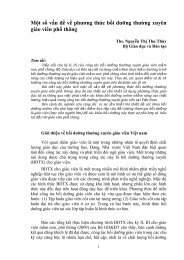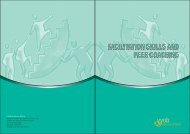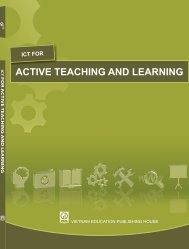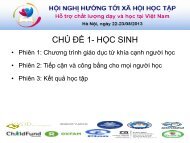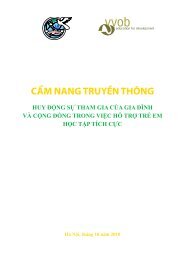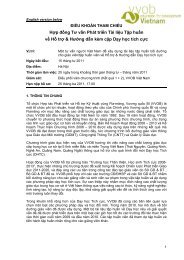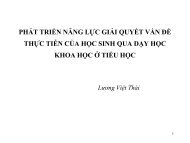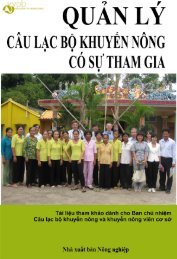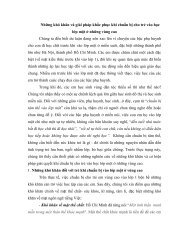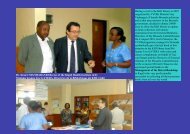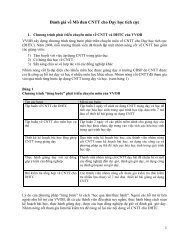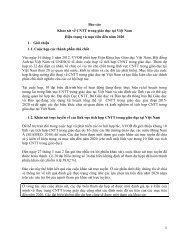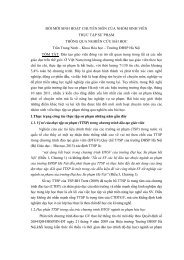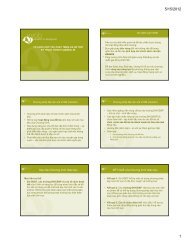Kenya Multi-Year Programme 2011-2013 - VVOB
Kenya Multi-Year Programme 2011-2013 - VVOB
Kenya Multi-Year Programme 2011-2013 - VVOB
- No tags were found...
Create successful ePaper yourself
Turn your PDF publications into a flip-book with our unique Google optimized e-Paper software.
4. Analysis of the <strong>VVOB</strong> support4.1. History & antecedents of the collaboration4.1.1. The <strong>Kenya</strong> Country <strong>Programme</strong>The collaboration between <strong>VVOB</strong> and the <strong>Kenya</strong> Government started in 1989 with the secondment oflecturers to national universities (till 1995) and medical officers for district hospitals (till 2002). Up till1999, the ―technical assistants‖ were the main feature of the <strong>VVOB</strong> programme. This evolved, throughincreased budgets, from 1996 onwards, to a project approach with clear work plans, objectives andstronger monitoring and evaluation. Since 1994, there was also a clear shift from ―substitution‖ tocapacity development. One of the new partners at the time, was the National Museums of <strong>Kenya</strong>. Thepartnership lasted till December 2007.The Skillslab project (2000-2004) at the <strong>Kenya</strong> Medical Training College in Nairobi was the first projectfor <strong>VVOB</strong> in <strong>Kenya</strong>. It was followed by a ―national extension‖ phase, which lasted till 31 March 2010.<strong>VVOB</strong> <strong>Kenya</strong> also carried out a number of initiatives in the technical sub-sector. First, in 1998, withThe <strong>Kenya</strong> Polytechnic in Nairobi (till end 2007) as partner and, from 2002 to 2006, also with the<strong>Kenya</strong> Technical Teachers Training College (KTTC).The ―Training Capacity Building Project‖ (2003-2007) with the <strong>Kenya</strong> Education Staff Institute (KESI)kicked off the collaboration with the Ministry of Education.In 2008, the Ministry of Education became the main strategic (and operational) partner in <strong>VVOB</strong><strong>Kenya</strong>‘s first collaboration with a programme approach. This programme consists of two phases(2008-2010 and <strong>2011</strong>–<strong>2013</strong>). This document describes the second phase.4.1.2. The International <strong>Programme</strong>The <strong>VVOB</strong> programme <strong>Kenya</strong> has had a second pillar consisting in a collaboration with InternationalResearch Centra, and this from the early 1990s. This partnership ran in the wider East and CentralAfrican region. This programme component did not fully evolve to a project approach, mainly becauseof limited operational budgets assigned to it. But the programme experienced the same shift in focustowards capacity development, training and development of learning materials. The main <strong>VVOB</strong> inputremained technical expertise.The most important partners in the period till end 2007 were:ILRAD / ILRI (International Lifestock Research Institute) with headquarters in Nairobi and activitiesin <strong>Kenya</strong> (1990 – 1997)UNEP (United Nations Environment <strong>Programme</strong>) headquarters in Nairobi and activities in <strong>Kenya</strong>,Zanzibar, Tanzania, Mauritius, Comoros, Madagascar, Mozambique - (1995 -1999)IITA (International Centre for Tropical Agriculture) Uganda with activities in Uganda and Rwanda.(1999 - 2006) – and before then IITA NigeriaINIBAP (International Network for the Improvement of Banana and Plantain) – renamed ―BIoversityinternational) with activities in Uganda, Burundi, <strong>Kenya</strong>, Ethiopia, Mozambique, Rwanda (2003 –2007).ICRAF (International Centre for Research in Agroforestry) – “The World Agroforestry Centre” withheadquarters in Nairobi and activities in <strong>Kenya</strong>, Rwanda, Burundi, Zimbabwe, DRCongo, Uganda,Mali, Cameroon. But also in Indonesia, Thailand, China (1992- 2007).ICRAF remained a main partner in the MOE-<strong>VVOB</strong> collaboration programme 2008-2010, building onthe joint experience of the ―Farmers of the Future‖ initiative (2002 – 2007).Brief presentation and analysis of the achievements in the period 2008-2010<strong>Kenya</strong> - <strong>Multi</strong>-<strong>Year</strong> <strong>Programme</strong> <strong>2011</strong>-<strong>2013</strong> 20/148



